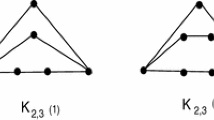Abstract
Let \(D\ne \mathbb {C}\) be a simply connected domain and f be a Riemann mapping from \(\mathbb {D}\) onto D. The Hardy number of D is the supremum of all p for which f belongs in the Hardy space \({H^p}\left( \mathbb {D} \right) \). A comb domain is a domain whose complement is the union of an infinite number of vertical rays symmetric with respect to the real axis. In this paper we prove that, for \(p>0\), there is a comb domain with Hardy number equal to p if and only if \(p\in [1,+\infty ]\). It is known that the Hardy number is related to the moments of the exit time of Brownian motion from the domain. In fact, Burkholder proved that the Hardy number of a simply connected domain is twice the supremum of all \(p>0\) for which the p-th moment of the exit time of Brownian motion is finite. Therefore, our result implies that given \( p < q\) there exists a comb domain with finite p-th moment but infinite q-th moment if and only if \(q\ge 1/2\). This answers a question posed by Boudabra and Markowsky.





Similar content being viewed by others
References
Beardon, A.F., Minda, D.: The hyperbolic metric and geometric function theory. In: Quasiconformal Mappings and Their Applications, Narosa, New Delhi, pp. 9–56 (2007)
Beurling, A.: The Collected Works of Arne Beurling, vol. 1, Complex Analysis. Birkhäuser, Boston (1989)
Boudabra, M., Markowsky, G.: On the finiteness of moments of the exit time of planar Brownian motion from comb domains. Ann. Acad. Sci. Fenn. Math. 46, 527–536 (2021)
Burkholder, D.L.: Exit times of Brownian motion, harmonic majorization, and Hardy spaces. Adv. Math. 26, 182–205 (1977)
Duren, P.L.: Theory of \(H^p\) Spaces. Academic Press, New York (1970)
Garnett, J.B., Marshall, D.E.: Harmonic Measure. Cambridge University Press, Cambridge (2005)
Hansen, L.J.: Hardy classes and ranges of functions. Michigan Math. J. 17, 235–248 (1970)
Hansen, L.J.: The Hardy class of a spiral-like function. Michigan Math. J. 18, 279–282 (1971)
Karafyllia, C.: On the Hardy Number of Comb Domains (preprint). arXiv:2101.10477
Karafyllia, C.: On the Hardy number of a domain in terms of harmonic measure and hyperbolic distance. Ark. Mat. 58, 307–331 (2020)
Kim, Y.C., Sugawa, T.: Hardy spaces and unbounded quasidisks. Ann. Acad. Sci. Fenn. Math. 36, 291–300 (2011)
Markowsky, G.: Planar Brownian Motion and Complex Analysis (preprint). arXiv:2012.08574 (2020)
Poggi-Corradini, P.: The Hardy class of Kœnigs maps. Michigan Math. J. 44, 495–507 (1997)
Poggi-Corradini, P.: Geometric Models, Iteration and Composition Operators. Ph.D. Thesis, University of Washington (1996)
Author information
Authors and Affiliations
Corresponding author
Additional information
Communicated by Pekka Koskela.
Publisher's Note
Springer Nature remains neutral with regard to jurisdictional claims in published maps and institutional affiliations.
Rights and permissions
About this article
Cite this article
Karafyllia, C. The Range of Hardy Numbers for Comb Domains. Comput. Methods Funct. Theory 22, 743–753 (2022). https://doi.org/10.1007/s40315-021-00426-0
Received:
Revised:
Accepted:
Published:
Issue Date:
DOI: https://doi.org/10.1007/s40315-021-00426-0



